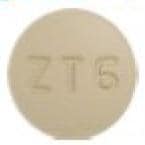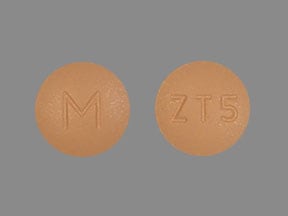Dosage Forms
Excipient information presented when available (limited, particularly for generics); consult specific product labeling.
Solution, Nasal:
Zomig: 2.5 mg (6 ea); 5 mg (6 ea)
Tablet, Oral:
Zomig: 2.5 mg [scored]
Zomig: 5 mg
Generic: 2.5 mg, 5 mg
Tablet Disintegrating, Oral:
Zomig ZMT: 2.5 mg, 5 mg [contains aspartame; orange flavor]
Generic: 2.5 mg, 5 mg
Pharmacology
Mechanism of Action
Selective agonist for serotonin (5-HT1B and 5-HT1D receptors) in cranial arteries and sensory nerves of the trigeminal system; causes vasoconstriction and reduces inflammation associated with antidromic neuronal transmission correlating with relief of migraine
Pharmacokinetics/Pharmacodynamics
Absorption
Well absorbed
Distribution
Vd: Oral: 7 L/kg; Nasal spray: 8.4 L/kg
Metabolism
Converted to an active N-desmethyl metabolite (2-6 times more potent than zolmitriptan at 5-HT1B and 5-HT1D receptors)
Excretion
Urine (~60% to 65% total dose; 8% of total dose as unchanged drug; 4% of total dose as N-desmethyl metabolite); feces (30%)
Time to Peak
Serum: Tablet: 1.5 hours; Orally-disintegrating tablet and nasal spray: 3 hours
Half-Life Elimination
3 hours
Protein Binding
25%
Use in Specific Populations
Special Populations: Renal Function Impairment
Clearance of oral zolmitriptan was reduced 25% in patients with severe renal impairment (CrCl 5 to 25 mL/minute).
Special Populations: Hepatic Function Impairment
In severely hepatically impaired patients, the Cmax, Tmax, and AUC were increased 1.5-, 2-, and 3-fold, respectively, when dosed orally.
Special Populations: Gender
Mean plasma concentrations of oral zolmitriptan were up to 1.5-fold higher in women than men.
Use: Labeled Indications
Migraines:
Nasal inhalation: Acute treatment of migraine with or without aura in adults and pediatric patients ≥12 years.
Oral: Acute treatment of migraine with or without aura in adults.
Use: Off Label
Cluster headache, treatmentayes
Data from three double-blind, randomized, cross-over, placebo-controlled trials support the use of zolmitriptan (nasal spray and oral routes) in the acute treatment of cluster headache. Relief rates were higher in patients with episodic cluster headaches in comparison to chronic cluster headache Bahra 2000, Cittadini 2006, Rapoport 2007.
Based on the American Headache Society guidelines for the treatment of cluster headache, zolmitriptan nasal spray is effective and recommended and oral zolmitriptan is probably effective and recommended for the acute treatment of cluster headaches.
Menstrual migraines (short-term prevention)ayes
Data from a randomized placebo-controlled trial supports the use of zolmitriptan in the short-term prevention of menstrual migraines Tuchman 2008.
Based on the American Academy of Neurology and the American Headache Society evidence-based guideline update: Pharmacologic treatment for episodic migraine prevention in adults, zolmitriptan is probably effective and may be considered as an alternative agent in the prevention of menstrual migraines.
Contraindications
Hypersensitivity to zolmitriptan or any component of the formulation; ischemic coronary artery disease (angina pectoris, history of myocardial infarction [MI], or documented silent ischemia); coronary artery vasospasm, including Prinzmetal variant angina, or other significant underlying cardiovascular disease; Wolff-Parkinson-White syndrome or arrhythmias associated with other cardiac accessory conduction pathway disorders; peripheral vascular disease; ischemic bowel disease; uncontrolled hypertension; recent use (within 24 hours) of treatment with another 5-HT1 agonist, or an ergotamine-containing or ergot-type medication like dihydroergotamine or methysergide; history of stroke, transient ischemic attack, or history of hemiplegic or basilar migraine; coadministration of monoamine oxidase A (MAO A) inhibitors or use of zolmitriptan within 2 weeks of discontinuation of MAO A inhibitor therapy.
Documentation of allergenic cross-reactivity for triptans is limited. However, because of similarities in chemical structure and/or pharmacologic actions, the possibility of cross-sensitivity cannot be ruled out with certainty.
Canadian labeling: Additional contraindications (not in US labeling): Valvular heart disease; ophthalmoplegic migraine.
Dosage and Administration
Dosing: Adult
Cluster headache, treatment (off-label): Nasal inhalation (available as a 2.5 or 5 mg dose per nasal sprayer) or oral: Usual dose: 5 to 10 mg at the onset of cluster headache (maximum single dose: 10 mg) (Bahra 2000; Cittadini 2006; Rapoport 2007).
Migraine:
Initial dose: Note: Administer at the onset of migraine headache.
Nasal inhalation: 2.5 mg (maximum single dose: 5 mg)
Oral:
Tablet: 1.25 to 2.5 mg (maximum single dose: 5 mg)
Orally disintegrating tablet: 2.5 mg (maximum single dose: 5 mg)
Second dose (either nasal inhalation or oral): May repeat in 2 hours if the migraine headache has not resolved or returns after transient improvement (maximum daily dose: 10 mg)
Menstrual migraine, prophylaxis (off-label use): Oral: 2.5 mg 2 to 3 times daily starting 2 days prior to the expected onset of menses and continued through to 5 days after the onset of menses (7 days total) (Tuchman 2008)
Dosage adjustment for concomitant therapy with cimetidine: Maximum single dose: 2.5 mg (maximum daily dose: 5 mg)
Dosing: Geriatric
Refer to adult dosing. Initiate therapy at the low end of the dosing range.
Dosing: Pediatric
Migraine: Children ≥12 years and Adolescents: Intranasal: Nasal inhalation:
Initial dose: 2.5 mg; may titrate as individual response may vary; maximum single dose: 5 mg/dose; Note: Administer at the onset of migraine headache.
Second dose: May repeat in 2 hours if the migraine headache has not resolved or returns after transient improvement; maximum daily dose: 10 mg/day
Dosing adjustment for concomitant therapy with cimetidine: Nasal spray: Children ≥12 years and Adolescents: Maximum single dose: 2.5 mg; maximum daily dose: 5 mg/day
Administration
Administer as soon as migraine headache starts.
Tablet: May be broken in half to achieve a smaller initial dose.
Orally-disintegrating tablet: Must be taken whole; do not break, crush, or chew. Place on tongue and allow to dissolve. Administration with liquid is not required.
Nasal spray: Blow nose gently prior to use. After removing protective cap, instill device into nostril. Block opposite nostril; breathe in gently through nose while pressing plunger of spray device. Breathe gently through mouth for 5-10 seconds.
Dietary Considerations
Some products may contain phenylalanine.
Storage
Store at 20°C to 25°C (68°F to 77°F). Protect tablets from light and moisture.
ZOLMitriptan Images
Drug Interactions
Cimetidine: May increase the serum concentration of ZOLMitriptan. Management: Limit the maximum single dose of zolmitriptan to 2.5 mg, not to exceed 5 mg in 24 hours, when coadministered with cimetidine. Consider therapy modification
Droxidopa: Serotonin 5-HT1D Receptor Agonists (Triptans) may enhance the hypertensive effect of Droxidopa. Monitor therapy
Ergot Derivatives: May enhance the vasoconstricting effect of Serotonin 5-HT1D Receptor Agonists (Triptans). Serotonin 5-HT1D Receptor Agonists (Triptans) may enhance the vasoconstricting effect of Ergot Derivatives. Exceptions: Nicergoline. Avoid combination
Monoamine Oxidase Inhibitors: Serotonin 5-HT1D Receptor Agonists (Triptans) may enhance the serotonergic effect of Monoamine Oxidase Inhibitors. This could result in serotonin syndrome. Monoamine Oxidase Inhibitors may increase the serum concentration of Serotonin 5-HT1D Receptor Agonists (Triptans). Exceptions: Rasagiline; Safinamide; Selegiline. Avoid combination
Propranolol: May increase the serum concentration of ZOLMitriptan. Monitor therapy
Serotonergic Agents (High Risk): Serotonin 5-HT1D Receptor Agonists (Triptans) may enhance the serotonergic effect of Serotonergic Agents (High Risk). This could result in serotonin syndrome. Management: Monitor for signs and symptoms of serotonin syndrome/serotonin toxicity (eg, hyperreflexia, clonus, hyperthermia, diaphoresis, tremor, autonomic instability, mental status changes) when these agents are combined. Exceptions: Isocarboxazid; Linezolid; Methylene Blue; Moclobemide; Phenelzine; Tranylcypromine. Monitor therapy
SUMAtriptan: Serotonin 5-HT1D Receptor Agonists (Triptans) may enhance the adverse/toxic effect of SUMAtriptan. Avoid combination
Adverse Reactions
>10%: Gastrointestinal: Unpleasant taste (nasal: adults: 17% to 21%; children & adolescents: 6% to 10%)
1% to 10%:
Cardiovascular: Chest pain (oral: 2% to 4%), chest pressure (nasal: 1% to <2%), facial edema (nasal: 1% to <2%), palpitations (nasal: 1% to <2%), cardiac arrhythmia (≤1%), hypertension (≤1%), syncope (≤1%), tachycardia (≤1%)
Central nervous system: Dizziness (adults: 6% to 10%; children & adolescents: 2%), paresthesia (5% to 10%), drowsiness (4% to 8%), local alterations in temperature sensations (oral: 5% to 7%), sensation of pressure (oral: 2% to 5%), hyperesthesia (nasal: 1% to 5%), (1% to 5%), flushing sensation (nasal: 4%), pain (nasal: 2% to 4%), vertigo (oral: 2%), chills (nasal: 1% to <2%), depersonalization (nasal: 1% to <2%), headache (1% to <2%), agitation (≤1%), amnesia (≤1%), anxiety (≤1%), depression (≤1%), emotional lability (oral: ≤1%), insomnia (≤1%), nervousness (nasal: ≤1%)
Dermatologic: Diaphoresis (oral: 2% to 3%), pruritus (≤1%), skin rash (≤1%), urticaria (≤1%)
Gastrointestinal: Nausea (adults: 4% to 9%; children & adolescents: 2%), xerostomia (2% to 5%), dyspepsia (oral: 2% to 3%), dysphagia (1% to 2%), abdominal pain (nasal: 1% to <2%), vomiting (1% to <2%)
Genitourinary: Urinary frequency (oral: ≤1%), urinary urgency (≤1%)
Hypersensitivity: Hypersensitivity reaction (≤1%)
Local: Local pain (4% to 10%; neck/throat/jaw), application site irritation (nasal: 3%)
Neuromuscular & skeletal: Weakness (oral: 5% to 9%; nasal: 3%), arthralgia (nasal: 1% to <2%), myalgia (nasal: 1% to <2%)
Otic: Tinnitus (≤1%)
Renal: Polyuria (≤1%)
Respiratory: Nasal discomfort (nasal: 3%), constriction of the pharynx (nasal: 2%), pressure on pharynx (nasal: 1% to <2%), bronchitis (nasal: ≤1%), cough (nasal: ≤1%), dyspnea (nasal: ≤1%), epistaxis (nasal: ≤1%), laryngeal edema (nasal: ≤1%), pharyngitis (nasal: ≤1%), rhinitis (nasal: ≤1%), sinusitis (nasal: ≤1%)
<1%, postmarketing, and/or case reports: Abnormal dreams, abnormality in thinking, altered sense of smell, amblyopia, anaphylactoid reaction, anaphylaxis, angina pectoris, angioedema, apathy, ataxia, atrial fibrillation, back pain, bradycardia, breast carcinoma, breast neoplasm, bruise, cellulitis, cerebral ischemia, colitis, confusion, conjunctivitis, constipation, convulsions, coronary artery vasospasm, cyanosis, cyst, cystitis, diarrhea, dry eye syndrome, dysmenorrhea, eczema, eructation, erythema, erythema multiforme, euphoria, eye pain, fever, fibrocystic breast disease, flu-like symptoms, gastritis, gastrointestinal carcinoma, gastrointestinal infarction, gastrointestinal necrosis, genitourinary neoplasm, gingivitis, hallucination, hepatic neoplasm, hiccups, hypertensive crisis, hyperthyroidism, hypertonia, hyperventilation, increased appetite, increased bronchial secretions, increased thirst, infection, intestinal obstruction, irritability, ischemic colitis, ischemic heart disease, lacrimation, laryngitis, leukopenia, mania, menorrhagia, myocardial infarction, neoplasm, neuropathy, otalgia, photophobia, pneumonia, psychosis, pyelonephritis, renal pain, salivation, seizure, serotonin syndrome, sialadenitis, skin neoplasm, splenic infarction, stomatitis, tardive dyskinesia, tenosynovitis, thrombophlebitis, thyroid edema, tongue edema, tremor, twitching, urinary tract infection, uterine fibroid enlargement, uterine hemorrhage, vaginitis, vasodilation, ventricular fibrillation, ventricular tachycardia, visual field defect, voice disorder, yawning
Warnings/Precautions
Concerns related to adverse effects:
- Cardiac events: Coronary artery vasospasm, transient ischemia, myocardial infarction, ventricular tachycardia/fibrillation, cardiac arrest, and death have been reported within a few hours of 5-HT1 agonist administration; use is contraindicated in patients with ischemic or vasospastic coronary artery disease. Patients who experience sensations of chest pain/pressure/tightness or symptoms suggestive of angina following dosing should be evaluated for coronary artery disease or Prinzmetal's angina before receiving additional doses; if dosing is resumed and similar symptoms recur, monitor with ECG. Patients with Prinzmetal's variant angina, Wolff-Parkinson-White Syndrome or arrhythmias associated with other cardiac accessory conduction pathway disorders should not receive zolmitriptan.
- Cerebrovascular events: Cerebral/subarachnoid hemorrhage and stroke have been reported with 5-HT1 agonist administration and some have resulted in fatalities. Do not administer to patients with a history of stroke or TIA; discontinue use if a cerebrovascular event occurs.
- Elevated blood pressure: Significant elevation in blood pressure, including hypertensive crisis, has also been reported on rare occasions in patients with and without a history of hypertension. Use is contraindicated in patients with uncontrolled hypertension.
- Vasospasm-related events: Peripheral vascular ischemia, gastrointestinal vascular ischemia and infarction (presenting with abdominal pain and bloody diarrhea), splenic infarction, and Raynaud syndrome have been reported with 5-HT1 agonists. In patients who experience signs or symptoms suggestive of a vasospastic reaction following use of a 5-HT1 agonist, rule out a vasospastic reaction before receiving additional doses.
- Visual effects: Rarely, partial vision loss and blindness (transient and permanent) have been reported with 5-HT1 agonists.
Disease-related concerns:
- Coronary artery disease: Should not be given to patients who have risk factors for CAD (eg, hypertension, hypercholesterolemia, smoker, obesity, diabetes, strong family history of CAD, menopause, male >40 years of age) without adequate cardiac evaluation. Patients with suspected CAD should have cardiovascular evaluation to rule out CAD before considering use; if cardiovascular evaluation is “satisfactory,” first dose should be given in the healthcare provider's office (consider ECG monitoring). Periodic evaluation of cardiovascular status should be done in all patients.
- Hepatic impairment: Use with caution in patients with hepatic impairment. Drug clearance may be reduced leading to increased plasma concentrations. With moderate to severe hepatic impairment, dosage reduction of the oral product is recommended; use of orally disintegrating tablet and nasal inhalation are not recommended in moderate to severe hepatic impairment.
Concurrent drug therapy issues:
- Drug-drug interactions: Potentially significant interactions may exist, requiring dose or frequency adjustment, additional monitoring, and/or selection of alternative therapy. Consult drug interactions database for more detailed information.
- Serotonin syndrome: Symptoms of agitation, confusion, hallucinations, labile blood pressure, hyper-reflexia, incoordination, myoclonus, shivering, and tachycardia may occur with concomitant proserotonergic drugs (eg, SSRIs, SNRIs, TCAs, MAO inhibitors) or agents which reduce zolmitriptan's metabolism.
Special populations:
- Elderly: Elderly patients are more likely to have underlying cardiovascular disease and hepatic or renal impairment; use with caution. Cardiovascular evaluation is recommended for elderly patients with other cardiovascular risk factors prior to initiation of therapy.
Dosage form specific issues:
- Phenylalanine: Zomig-ZMT tablets contain phenylalanine.
Other warnings/precautions:
- Appropriate use: Only indicated for acute treatment of migraine headache; not indicated for migraine prophylaxis (used off-label for menstrual migraine prophylaxis) or for the treatment of cluster headache. Acute migraine agents (eg, triptans, opioids, ergotamine, or a combination of the agents) used for 10 or more days per month may lead to worsening of headaches (medication overuse headache); withdrawal treatment may be necessary in the setting of overuse. The safety of treating >3 headaches (oral) or >4 headaches (nasal inhalation) during a 30 day period has not been established. If a patient does not respond to the first dose, the diagnosis of migraine should be reconsidered; rule out underlying neurologic disease in patients with atypical headache and in patients with no prior history of migraine.
Monitoring Parameters
Headache severity, signs/symptoms suggestive of angina; blood pressure; ECG with first dose in patients with likelihood of unrecognized coronary disease, such as patients with significant hypertension, hypercholesterolemia, obese patients, patients with diabetes, smokers with other risk factors or strong family history of coronary artery disease
Pregnancy
Pregnancy Considerations
Information related to zolmitriptan use in pregnancy is limited in comparison to other medications in this class (Källén 2011; Nezvalová-Henriksen 2010; Nezvalová-Henriksen 2012; Nezvalová-Henriksen 2013; Spielmann 2018).
Until additional information is available, other agents are preferred for the initial treatment of migraine in pregnancy (MacGregor 2014; Worthington 2013).
Patient Education
What is this drug used for?
- It is used to treat migraine headaches.
Frequently reported side effects of this drug
- Loss of strength and energy
- Fatigue
- Sensation of warmth
- Nausea
- Vomiting
- Dry mouth
- Nasal irritation
- Change in taste
Other side effects of this drug: Talk with your doctor right away if you have any of these signs of:
- Heart attack like chest pain; pain in arms, back, neck, jaw, or abdomen; shortness of breath; cold sweats; severe dizziness; passing out; or severe nausea or vomiting
- Severe cerebrovascular disease like change in strength on one side is greater than the other, difficulty speaking or thinking, change in balance, or vision changes
- Severe or persistent headache
- Vision changes
- Severe dizziness
- Passing out
- Blindness
- Constipation
- Diarrhea
- Severe abdominal pain
- Bloody stools
- Weight loss
- Leg cramps
- Feeling of heaviness in legs
- Sensation of cold
- Burning or aching in feet or toes
- Shortness of breath
- Mood changes
- Burning or numbness feeling
- Serotonin syndrome like dizziness, severe headache, agitation, sensing things that seem real but are not, fast heartbeat, abnormal heartbeat, flushing, tremors, sweating a lot, change in balance, severe nausea, or severe diarrhea
- Signs of a significant reaction like wheezing; chest tightness; fever; itching; bad cough; blue skin color; seizures; or swelling of face, lips, tongue, or throat.
Note: This is not a comprehensive list of all side effects. Talk to your doctor if you have questions.
Consumer Information Use and Disclaimer: This information should not be used to decide whether or not to take this medicine or any other medicine. Only the healthcare provider has the knowledge and training to decide which medicines are right for a specific patient. This information does not endorse any medicine as safe, effective, or approved for treating any patient or health condition. This is only a brief summary of general information about this medicine. It does NOT include all information about the possible uses, directions, warnings, precautions, interactions, adverse effects, or risks that may apply to this medicine. This information is not specific medical advice and does not replace information you receive from the healthcare provider. You must talk with the healthcare provider for complete information about the risks and benefits of using this medicine.









